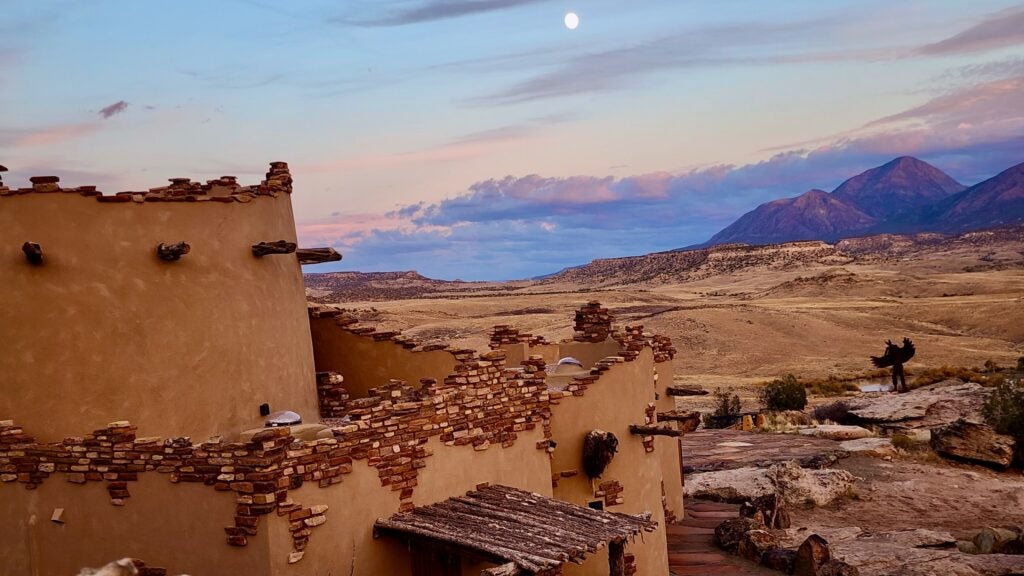No products in the cart.
Outdoor Adventure
The Best Dark-Sky Retreats in North America
Some people book hotels for high-quality gyms; others prioritize al fresco bathtubs. For me, an astrophotographer, accommodation selection comes down to one thing: stargazing potential.
With the recent astrotourism boom, due in part to the amazing northern-lights viewing in the U.S. this year, many lodges have bolstered their night-sky offerings. But not all dark-sky retreats are created equally. Simply having a view of constellations or being located near a low-light-pollution park doesn’t necessarily make for a stellar stargazing hotel.
A true dark-sky retreat makes the nightscape a main attraction. I’ve traveled to my fair share of properties that fit this bill, and others I can’t wait to check into for a night of cosmos-watching. Here are the ones I recommend in the U.S., Canada, and Mexico.
Sky Village at Canyon of the Ancients Guest Ranch
Cortez, Colorado
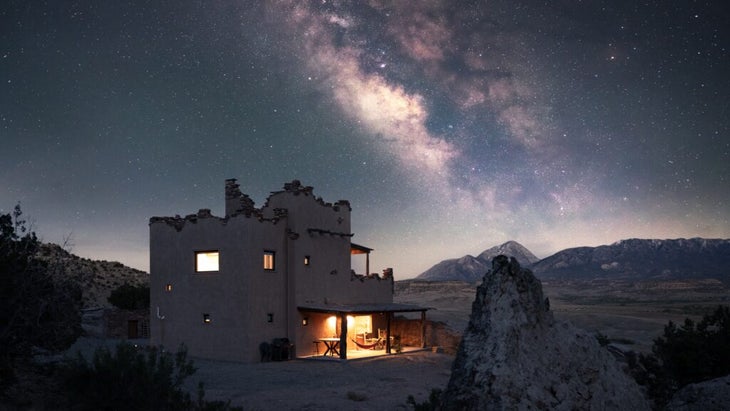
Hidden among the mesas and grassy valleys of the arid Colorado Plateau lies one of my favorite Milky Way–watching lookouts on the continent: Canyon of the Ancients Guest Ranch. The southwestern Colorado getaway, bookended between its namesake monument and the Ute Mountain Reserve, enjoys pristine night views best enjoyed from the new Star Tower, a two-story structure with views of Sleeping Ute Mountain that opened in 2023.
Its architecture is reminiscent of the Ancestral Puebloan cliff dwellings found at nearby Mesa Verde National Park, located 30 miles east. You can spend days here bouncing between parks, hiking the nearby trails, and meeting the ranch’s farm animals. Come nightfall, all eyes are on the sky—particularly if you’re relaxing on the tower’s star-view deck. From $515
oTentik
Grasslands National Park, Saskatchewan
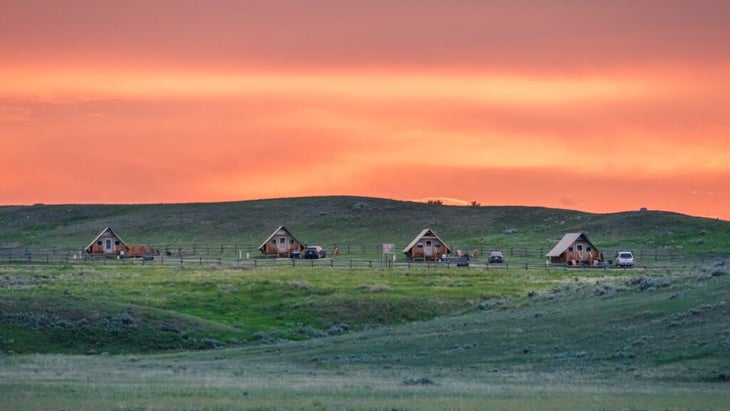
As our northern neighbor’s inkiest dark-sky preserve, certified by the Royal Astronomical Society of Canada, this national park’s nightscapes are about as star-speckled as they were when the dinosaurs tromped here—a history that draws fossil hunters and astrotourists alike.
Few accommodations exist in this 280-square-mile swath of mixed-grass prairie, but you can book Parks Canada’s oTentik, a collection of 12 cozy safari-style accommodations in the Frenchman Valley and Rock Creek campgrounds, designed with both sleeping and living-room spaces for up to six people. Based here, you can scour for fossils and admire the resident buffalo by day and gaze across 360 degrees of starry skies from your tent perch come dusk.
It’s worth mentioning that the park is ideally situated near the remote Saskatchewan-Montana border, a spot known for aurora sightings. Like many of our favorite contiguous U.S. aurora-hunting spots, lights viewing can occur here year-round. From $115
Under Canvas Bryce Canyon
Widtsoe, Utah

Under Canvas, lauded for its upscale, national-park-adjacent glamp sites, made an astrotourism splash in 2023 when it partnered with global light-pollution authority DarkSky International to turn a handful of its camps into the first DarkSky-certified resorts. At this especially incredible 50-tent outpost, located just 15 miles north of Bryce Canyon, an International DarkSky Park, the skies turn particularly dusky each night.
According to the nine-level Bortle Scale of light pollution, the property’s skies have the darkest rating: Class 1. Admire constellations from your private porch, join guided stargazing sessions, try meditative star bathing, or get hands on with community telescopes. The crème de la crème for space enthusiasts is the Stargazer tent, which features a large skylight to admire starry skies as as you doze off.
Under Canvas Bryce Canyon, is open from May through September. From $472
Fresh Coast Cabins
Eagle Harbor, Michigan
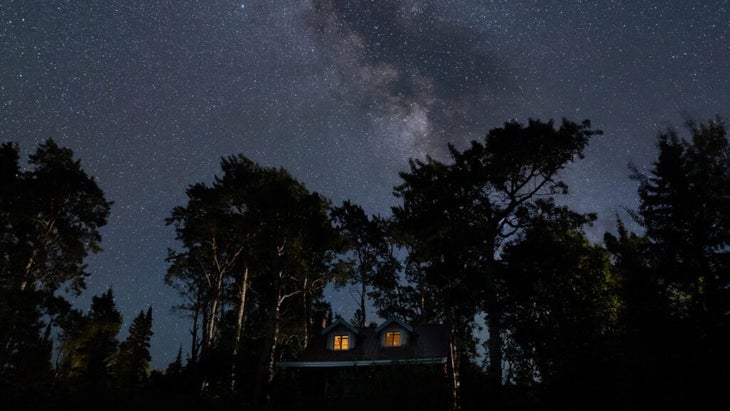
While I’ve enjoyed northern lights sightings around the world, few places have been as lucky for me as Fresh Coast Cabins, ten trendy, family-owned cabins on Michigan’s Keweenaw Peninsula. It ticks every box on my lower 48 aurora-hunting checklist: a clear, north-facing view across Lake Superior—essential for catching the swirls since they appear closer to the horizon in lower latitudes—and virtually no light pollution.
Its spacious campfire-gathering space draws guests outdoors at night for a few hours of star- and aurora-gazing, but I recommend that avid sky-watchers book Cabin Nine or the slightly pricier Aurora Major Suite. Both boast private porches with sweeping lake views. After a dose of astronomical awe, pop into the property’s new Takka Sauna, a traditional Finnish construction, then trot the path down to the lake for a reinvigorating dip in its waters. Repeat as needed. From $300
Four Seasons Resort Lanai
Lanai City, Hawaii
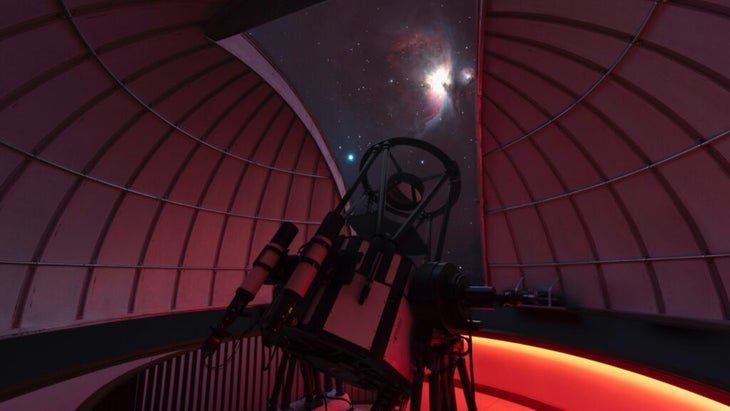
The 213-room Four Seasons Resort Lanai may be a five-star splurge, but for night-sky buffs interested in stargazing as well as authentic Native culture, it’s worth it. The resort, set on this small, palm-fringed island roughly an hour via ferry from Maui, runs an on-site observatory that spotlights both the stars and the stories of the Indigenous Hawaiians and Pacific Islanders that long relied on them for navigation. The observatory is also open to residents during special community events and for STEM internship programs for local students.
Expert-led star talks delve into celestial navigation history, and you can peer through a 3.2-foot telescope for a closer look at the skies. Other evening activities at the resort include full-moon themed dinners and guided starlit meditations overlooking Holopoe Bay, where the crashing waves add a splash of sound therapy. From $1,500
Pleasant Acres Reindeer Ranch
Pleasant Valley, Alaska
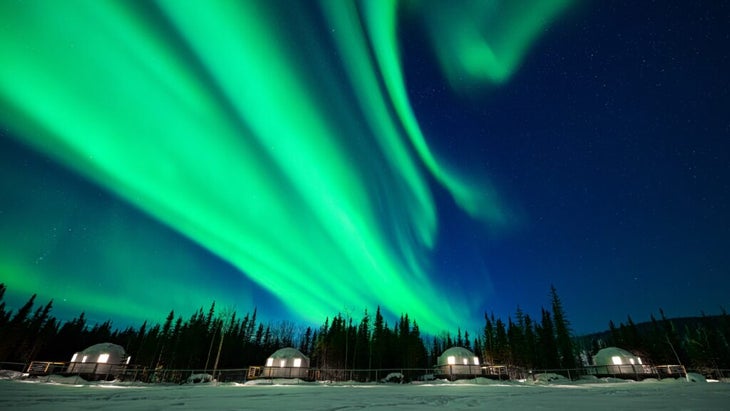
Aurora hunting from Pleasant Acres Reindeer Ranch, a new getaway some 30 miles east of Fairbanks, is like sky-watching from a holiday snow globe. The 18-acre property is about as North Pole as U.S. travel gets. There are four igloo-style domes, named after caribou herds in Alaska, and each with a private deck positioned just above a bustling reindeer hangout. That means endless nights of watching for the northern lights with Santa’s helpers lazing nearby. Another thoughtful perk is a kitchenette equipped with a microwave—perfect for warming cocoa during long nights awake.
Worried about dozing through the show? Sign up for the ranch’s complimentary aurora alerts so you don’t miss a second of the colorful swirls. Daytime adventures include reindeer hikes and dogsled rides. And if you visit during the summer, the ranch has room-darkening shades for snoozing despite the all-hours midnight sun. From $280
The Oasis at Death Valley
Death Valley National Park, California
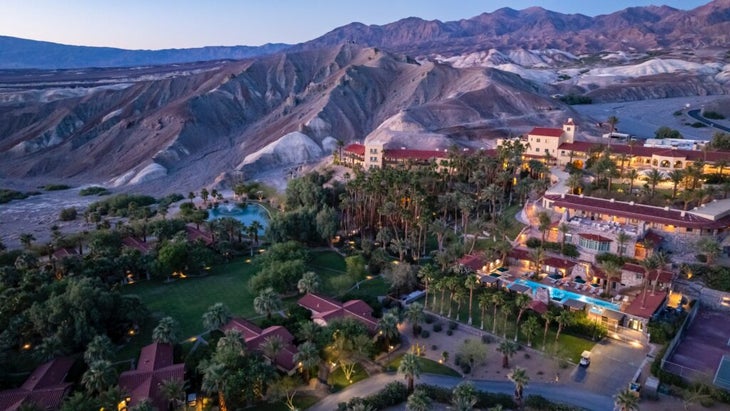
There’s a reason stargazers flock to this national park. Its remote and arid landscape, named a Gold Tier Dark Sky Park by DarkSky International, delights with obsidian skies across its 3.4 million acres of salt flats, sand dunes, and rainbow-hued hills. Even on bright-moon nights at the Oasis at Death Valley, I could spy countless stars. That said, it’s best to visit around a new moon, particularly in the less toasty months of October to February, for after-dark festivities that spotlight the park’s spellbinding skies.
The Oasis, included in DarkSky International’s certification of the park in 2013, offers two hotels: the higher-end Inn at Death Valley, with 66 rooms and 22 casitas, and the Ranch at Death Valley, with 275 rooms. You’ll enjoy the park’s signature nightscapes from either landing pad, particularly during the annual Dark Sky Festival in early March. Another great post-sunset adventure is the monthly moonlight horseback rides offered by Furnace Creek Stables ($120 for one hour). Ranch rooms from $170; inn rooms from $356
Rancho La Concepción
Los Manzanos, Mexico

A heaven full of stars awaits travelers willing to go off-grid to this small, sustainable, and Wi-Fi-free ranch in the wilderness of Baja California, some 115 miles southeast of Ensenada. Rancho La Concepción offers three rustic-chic cabins near the mountainous Parque Nacional Sierra de San Pedro Mártir, an area so dark that astronomers decided to situate the country’s second-largest telescope here. You can visit this observatory, a 23-mile drive east, during select public events, including presentations the first Friday of each month.
That said, Rancho La Concepción’s Bortle Class 1 skies make it hard to leave—particularly when the owners run space-sighting sessions with hot chocolate on hand. If there’s just one or two of you, book House of Stars to watch the sparkly skies from bed. From $130
Thorny Mountain Fire Tower
Seneca State Forest, West Virginia
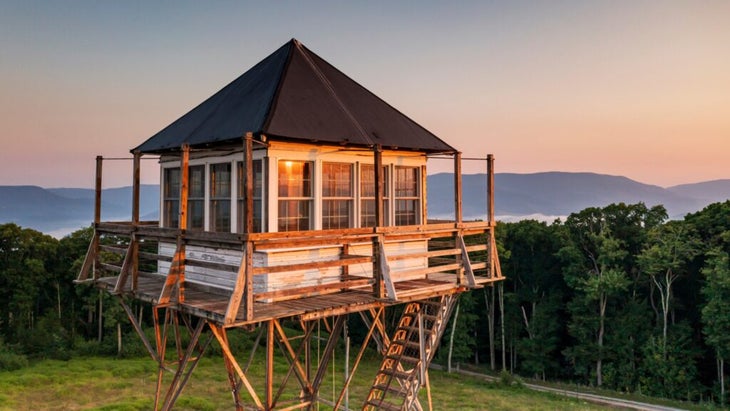
On the eastern side of West Virginia, a half-day’s drive from Washington, D.C., Seneca State Forest draws anglers and hikers eager to trek the area’s strech of the 330-mile Allegheny Trail. Come nightfall, there’s no better vantage point than the forest’s 65-foot-high Thorny Mountain Fire Tower, a refurbished accommodation and picturesque dark-sky retreat that juts well above the pines.
The two-bed tower can sleep up to four people and retains the rustic, low-frills aesthetic of its 1935 beginnings, with 360-degree windows and a wrap-around balcony that lets Mother Nature do the decorating. The digs, reached via 69 steps, are only available from April through October and get scooped up almost a year in advance. Once you’re there, staring up in wonder at the bright cosmos, it’s not hard to see why it’s so special. From $150
Compass Rose Lodge
Huntsville, Utah

The Ogden Valley isn’t solely for ski buffs. The eclectic 15-room Compass Rose Lodge illustrates the region’s astrotourism allure, starting with the on-site Huntsville Astronomic and Lunar Observatory. The stargazing haven, roughly 45 miles north of Salt Lake City, is open to guests and the local community, with telescopes to peer into space and nightly guided observations.
Also worthy of your time is the Ogden Valley Planet Tour, just 2.5 miles north of the Compass Rose. A 13-mile-long model of our solar system, the project includes sculptures and artistic renderings of the planets, best enjoyed on a ride along the Ogden Valley Bike Path (bike rentals are available at the lodge). From $279
Summit at Big Bend
Terlingua, Texas
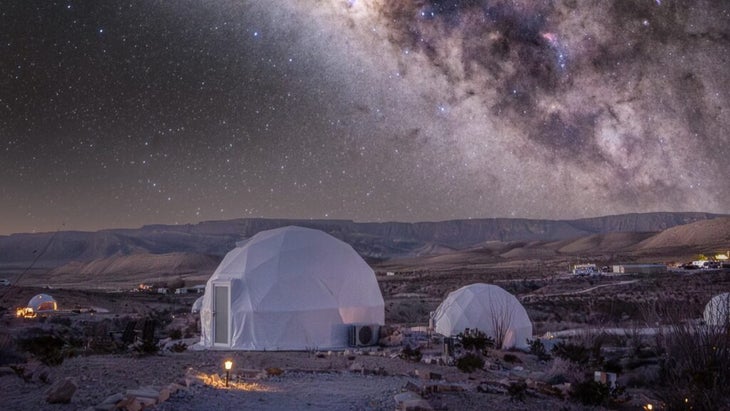
At nine million acres, southern Texas’s Greater Big Bend International Dark Sky Reserve is the largest dark sky reserve in the world. It encompasses not only Big Bend National Park but the ghost town of Terlingua and its nearby astro hub, the Summit at Big Bend. Its glamping accommodations, from domes to cave dwellings, offer jet-black Bortle Class 1 nightscapes across 1,000 private desert acres.
For astronomy fans, it’s tough to beat—or catch any shut-eye in—the property’s stargazing domes, where clear ceilings and front walls are optimal for watching the shrub-dotted desert transition from blue-sky day to shimmery polka-dotted twilight. Catch the cosmos from your dome or your own fire pit, or enjoy the reserve’s numerous other stargazing experiences, including astro programming in nearby Big Bend—its Maverick Junction entrance is 17 miles to the east. From $159
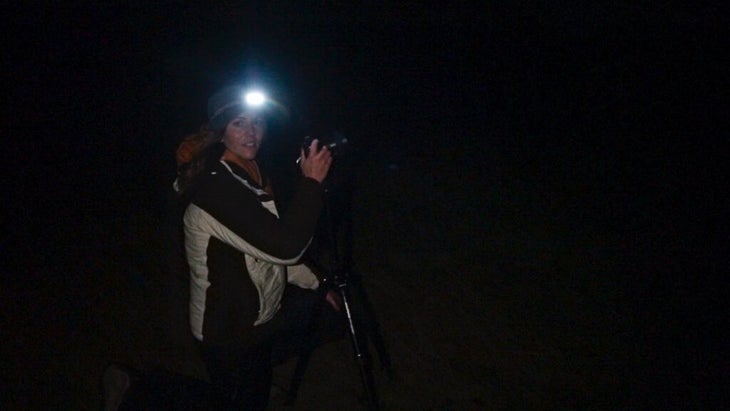
Adventure and astrotourism writer Stephanie Vermillion travels the globe in search of the best night-sky views, from stargazing-themed hotels to aurora-hunting campsites. Her upcoming book 100 Nights of a Lifetime: The World’s Ultimate Adventures After Dark will be out December 3.
Source link

